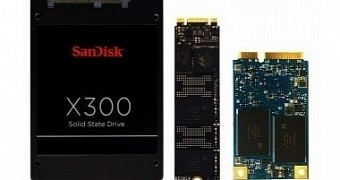Most solid state drives use MLC (multi-level cell) NAND flash chips and some sort of cache technology or other, but SanDisk didn't want its latest storage units to just be lost in the crowd, so it took some liberties.
MLC is just the standard name for the two-level cell NAND chip architecture. There are other types of chips as well, and we're not talking about SLC here (single-level cell).
While SLC offers some endurance benefits, among other things, it also limits storage capacity. It's also expensive.
So SSD makers have been experimenting with the option of multiplying the cells per chip. TLC, or triple-level cell NAND, was the result.
The SanDisk X300 SSD Series
This line of solid state storage devices is composed of 2.5-inch, mSATA and M.2 solid state drives, all of which are designed from TLC NAND.
They also boast the Ncache 2.0 tiered caching architecture, which supports SLC cache memory, boosting productivity and overall performance. It's an interesting sort of capability crossover.
SLC and X3/TLC flash blocks are essentially combines, leading to an improvement to endurance and efficiency. Corporate workloads like financial transactions, media creation and office applications should benefit because of that.
And with the variety in form factors that we already mentioned, SanDisk has essentially covered all possible types of office computers.
Multi-Page Recovery (MPR) is another asset built into the X300 SSD line. It protects data by implementing “page-level striping with distributed parity.” In layman’s terms, it means your data won't be so easily lost. Finally, performance is maximized due to an off-loading controller and DDR resources.
At the end of the day, the SanDisk X300 SSDs should be able to attain read and write speeds of 530 MB/s and 470 MB/s. Not the best, but not bad either, especially when the capacities can go as high as 1 TB (128 GB, 256 GB, 512 GB, 1 TB is the full list).
Besides, most speed ratings don't reflect real life performance anyway. On that note, those numbers were provided by the CrystalDiskMark benchmark.
Availability and pricing
SanDisk will be offering X300 solid state drives to business and corporate customers starting later this month (October 2014). A good piece of news is that Apricorn's EZ Gig IV cloning software will allow buyers to migrate from their old HDDs (or other SSDs) to the new ones without having to reinstall the OS, antivirus and other software. Unfortunately, the price wasn't mentioned in the announcement.

 14 DAY TRIAL //
14 DAY TRIAL //